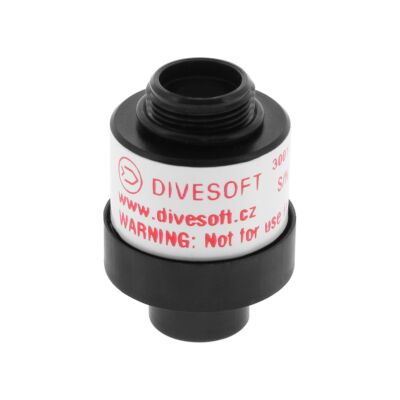Divesoft 22S Oxygen Sensor
- OEM Replacement oxygen sensor for the Divesoft gas analyzers
- Analyzer use ONLY, the R-22S type is NOT suitable for use in rebreathers
- Divesoft warranty of sensor life is 12 months
Divesoft 22S Oxygen Sensor
The Divesoft 22S Oxygen Sensor is a Divesoft branded replacement for the oxygen sensor with a three pin Molex connector in the Divesoft gas analyzers. The sensor is also a plug compatible replacement for R-22 sensors found in other gas analyzers such as Apeks DSX, Cochran Lifeguard, DiveTek Oz, DiveNav cootwo, Mares EANx, and OxySpy analyzers. Lacking a hydrophobic membrane, this sensor is NOT suitable for use in any rebreather.
The sensor’s accuracy is ± 1% full scale. Typical life of this type sensor is 36 to 48 months depending on usage and amount of oxygen being analyzed, but can be as little as 12 months in frequent shop use. Divesoft warranty of sensor life is 12 months.
We are occasionally asked about availability of the helium sensors for the Divesoft Trimix analyzers. They are available by special order, but Divesoft tells us that the helium sensors are not consumable, and expected to last the life of the analyzer.
| Brand | Divesoft |
|---|---|
| SKU | DS-3001 |
| Weight | 0.250000 |
Customer Reviews
 WARNING
WARNING
Oxygen sensors are one of the very few items on our website that are NOT returnable, because we can't know with absolute certainty how they were handled once delivered. Additional shipping and handling of the return can also degrade performance. They are critical to safety in diving, and our customers have a reasonable expectation of receiving as factory fresh a product as possible from Dive Gear Express. Your complete satisfaction is our goal, so please consider carefully before purchase.
R-22 Oxygen Sensors - 'D' type vs 'S' type
The R-22 oxygen sensors are all characterized by the same physical dimensions, electrical characteristics and 3-pin Molex connector. The primary difference between the "S" type sensor and the "D" type sensor is the presence of a hydrophobic membrane on the face of the diving grade sensor. The membrane improves resistance to moisture, but slows the response of the sensor to changes in oxygen partial pressures by several seconds.
In practice, for use in diving gas analyzer applications the slightly slower response time of diving grade sensors is little consequence with the benefit being the design is more resistant to moisture found on the face of tank valves. If the diver or fill station operator fails to wipe or blow away any moisture present on the valve outlet, that moisture can enter the stream of gas being analyzed and affect the accuracy of the analysis.
Some prefer to use the D type sensors even in analyzers because of their resistance to moisture, others prefer the S type sensors for their slightly faster response time in analyzers - especially in frequent use applications.
Dive Gear Express offers both types:
- Analytical Industries brand ADI-PSR-11-39-MD (R-22D type diving grade)
- Analytical Industries brand ADI-PSR-11-39-MNB (R-22S type for analyzers only)
- Divesoft brand DS-3001 (R-22S type for analyzers only)
- Mares rEvo brand CR22D (R-22D type diving grade)
- Poseidon brand 6010-206 (R-22D type diving grade)





